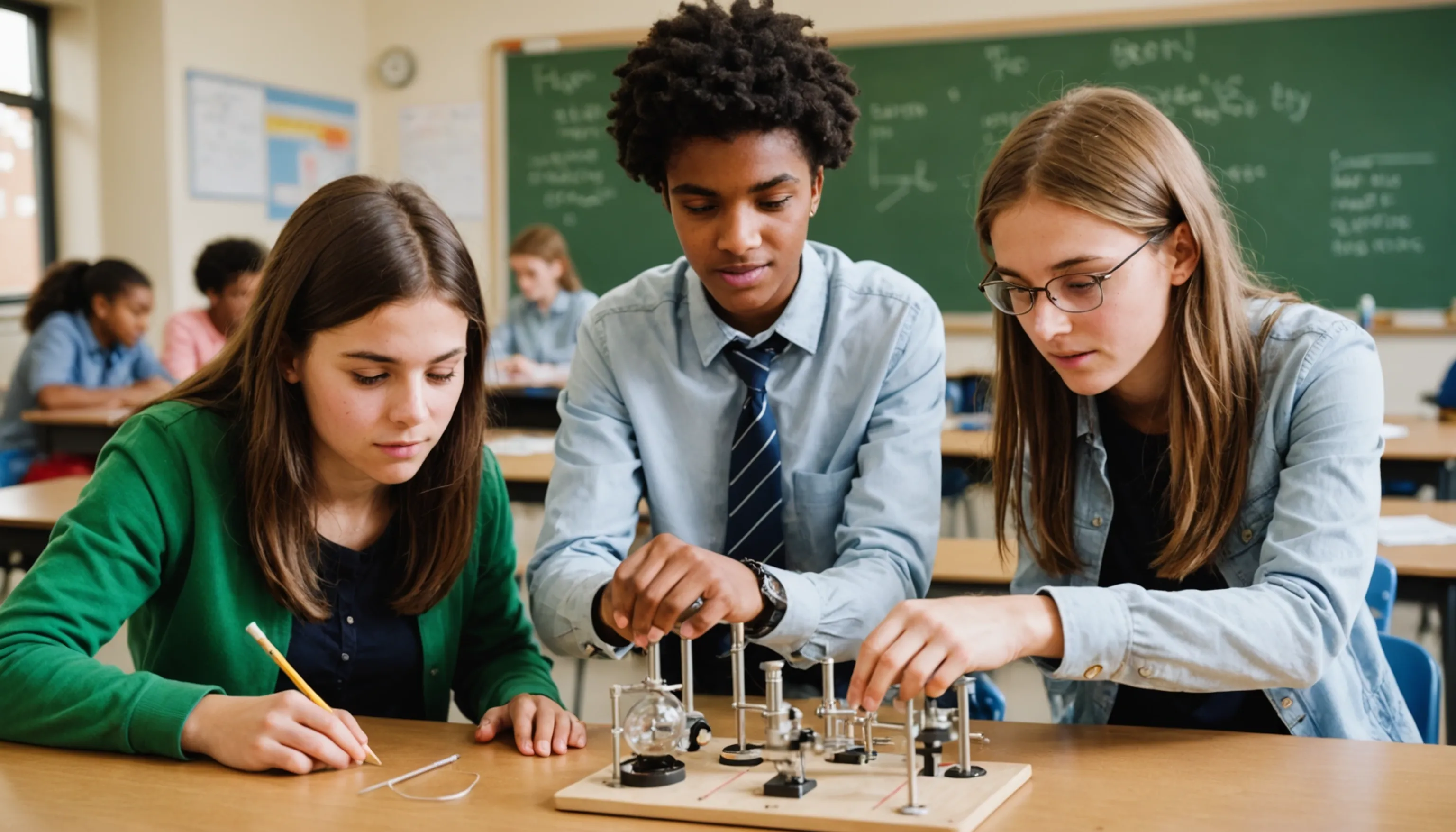Benefits of Physics Games for Learning
 HvWHenry van Wagenberg
HvWHenry van Wagenberg
The Benefits of Physics Games for Learning
Physics games offer numerous benefits for learning, especially for teenagers. These interactive tools make complex concepts more approachable and engaging. By incorporating game mechanics, students can explore physics in a fun, low-pressure environment.
One significant advantage is that these games foster active learning, encouraging students to experiment and see the immediate consequences of their actions. This hands-on approach helps reinforce theoretical knowledge and improves retention. Furthermore, physics games can cater to different learning styles, allowing students to grasp concepts at their own pace. Overall, they serve as a valuable resource for enhancing understanding.
How Physics Games Enhance Problem-Solving Skills
Physics games are not just entertaining; they play a crucial role in enhancing problem-solving skills among teenagers. These games immerse players in various scenarios that require critical thinking and strategic planning. As students navigate through challenges, they must apply physics principles to find solutions, which helps solidify their understanding of the subject.
In a typical physics game, players often encounter obstacles that demand them to analyze situations, test hypotheses, and make adjustments based on their outcomes. This iterative process mirrors real-world problem-solving, where failure can lead to learning and improvement. For instance, a game like Kerbal Space Program challenges players to build rockets and navigate through space, requiring them to calculate thrust, trajectory, and fuel consumption.
Moreover, these games encourage collaboration and communication when played in groups. Students can discuss strategies, share insights, and learn from one another, fostering a collaborative learning environment. This social aspect is vital, as it helps develop interpersonal skills alongside cognitive abilities.
Additionally, physics games often incorporate immediate feedback. Players can see the results of their actions in real time, allowing them to adjust their strategies quickly. This instant feedback loop enhances their ability to think critically and adapt their approaches, a key component of effective problem-solving. Overall, physics games serve as an engaging platform for teenagers to develop essential problem-solving skills that extend beyond the classroom.
Engaging Students Through Interactive Learning
Engaging students through interactive learning is essential in today’s educational landscape, and physics games are a powerful tool in achieving this goal. Traditional teaching methods often rely on lectures and textbooks, which can lead to disengagement, especially among teenagers. In contrast, interactive physics games offer a dynamic approach that captures students' attention and motivates them to learn.
These games provide a hands-on experience that allows students to explore physics concepts in a virtual environment. By participating actively, students are more likely to retain information and develop a deeper understanding of complex topics. For instance, games like PhET Interactive Simulations allow students to manipulate variables and see the immediate effects of their actions, fostering a sense of curiosity and experimentation.
Moreover, interactive learning through physics games promotes self-directed learning. Students can progress at their own pace, choosing challenges that match their skill levels, which boosts their confidence. This personalized learning experience is crucial for teenagers, as it empowers them to take ownership of their education.
Additionally, the competitive nature of many games can encourage collaboration among peers. When students work together to solve problems or complete missions, they develop teamwork and communication skills, essential for their future careers. Overall, physics games create an engaging learning environment that not only makes physics enjoyable but also cultivates critical skills necessary for academic and personal success.

Top Physics Games for Teenagers
Here are some of the top physics games for teenagers that combine fun with learning:
- Kerbal Space Program: Build and manage your own space program, learning about rocket science and orbital mechanics.
- PhET Interactive Simulations: Offers a variety of simulations that cover different physics concepts, allowing hands-on exploration.
- SimpleRockets 2: Create and launch rockets while understanding the principles of flight and gravity.
These games not only entertain but also enhance understanding of physics principles in an engaging way.
1. Kerbal Space Program
Kerbal Space Program is a groundbreaking game that captivates players with its unique blend of creativity and physics-based challenges. In this game, players are tasked with building and managing their own space program, which involves designing and launching spacecraft to explore celestial bodies. The game’s realistic physics engine allows players to experience the complexities of rocket science, including thrust, aerodynamics, and orbital mechanics.
One of the key features of Kerbal Space Program is the freedom it offers. Players can create a wide variety of spacecraft, from simple rockets to complex space stations. This hands-on approach encourages creativity, as students can experiment with different designs and see the immediate effects of their choices in a simulated environment.
As players progress, they learn about fundamental physics concepts such as gravity, momentum, and energy conservation. Successfully launching a spacecraft requires critical thinking and problem-solving skills, as players must calculate trajectories, manage fuel, and understand the mechanics of space travel.
The game also includes educational resources, making it an excellent tool for teachers and parents. It promotes STEM learning by engaging students in a fun, interactive way. Kerbal Space Program not only entertains but also instills a sense of curiosity about space and science, making it a top choice for teenagers looking to learn while having fun.
2. PhET Interactive Simulations
PhET Interactive Simulations is an innovative platform that offers a wide range of engaging, web-based simulations designed to teach physics and other STEM subjects. Created by the University of Colorado Boulder, PhET provides students with the opportunity to explore complex scientific concepts through interactive and visually appealing simulations.
One of the standout features of PhET is its focus on experiential learning. Students can manipulate variables and see real-time changes in simulations, which fosters a deeper understanding of physics principles. For example, in the "Forces and Motion" simulation, learners can experiment with different forces acting on an object and observe how those forces affect its motion. This hands-on experience allows students to visualize abstract concepts that are often challenging to grasp through traditional teaching methods.
PhET simulations are also designed to be user-friendly and accessible. They are suitable for a variety of learning levels, making them an excellent resource for both teachers and students. Educators can incorporate these simulations into lesson plans or use them as supplementary tools for hands-on exploration.
Furthermore, PhET encourages collaboration and discussion among peers, as students can work together to solve problems and share their insights. This collaborative environment not only enhances learning but also develops essential communication skills. Overall, PhET Interactive Simulations serve as a valuable resource for engaging students in physics and promoting a love for science through interactive learning.

3. SimpleRockets 2
SimpleRockets 2 is an engaging physics-based game that allows players to design, build, and launch their own rockets in a fun and interactive environment. This game is particularly appealing to teenagers as it combines creativity with the challenges of rocket science and space exploration.
In SimpleRockets 2, players can customize their rockets using a variety of parts, including engines, fuel tanks, and aerodynamic components. This hands-on approach not only sparks creativity but also teaches players about the essential principles of physics, such as thrust, drag, and gravity. As players experiment with different designs, they quickly learn how each component affects rocket performance.
The game features a realistic physics engine that simulates space travel, allowing players to experience the complexities of launching and navigating through the atmosphere and beyond. Players can embark on missions to explore celestial bodies, such as planets and moons, which adds an exciting layer of discovery and adventure.
Furthermore, SimpleRockets 2 encourages problem-solving skills as players must troubleshoot issues that arise during their missions. For instance, if a rocket fails to reach orbit, players can analyze their design choices and make adjustments for future launches. This iterative process mirrors real-world engineering challenges and promotes critical thinking.
Overall, SimpleRockets 2 is an excellent tool for teaching physics concepts while keeping students engaged and entertained. It fosters a love for science and space, making it a top choice for teenagers interested in rocket science and engineering.
Using Physics Games in Education
Using physics games in education is an innovative approach that can significantly enhance student learning. These games provide an interactive platform that engages teenagers and makes complex concepts more accessible. By incorporating gaming into the curriculum, educators can create an immersive learning environment where students can experiment and explore physics principles.
Physics games encourage active participation, allowing students to visualize and manipulate variables in real-time. This hands-on experience promotes deeper understanding and retention of knowledge. Moreover, these games cater to various learning styles, ensuring that all students can benefit.
Additionally, integrating physics games into lesson plans fosters collaboration among students. Working together to solve challenges encourages teamwork and communication, essential skills for their future careers. Overall, physics games are a valuable educational tool that not only makes learning enjoyable but also prepares students for real-world applications of physics.
Incorporating Games into Lesson Plans
Incorporating games into lesson plans is an effective strategy for enhancing student engagement and promoting a deeper understanding of physics concepts. When educators seamlessly integrate physics games into their curriculum, they create a dynamic learning environment that caters to different learning styles and keeps students motivated.
One approach is to identify specific learning objectives that align with the game’s content. For example, if a lesson focuses on the laws of motion, a teacher might use a game like Kerbal Space Program to illustrate these principles in action. By connecting game mechanics to theoretical concepts, students can see firsthand how physics applies to real-world scenarios.
Additionally, teachers can create structured activities around the games. This could involve assigning students to work in pairs or small groups, encouraging collaboration and discussion. After gameplay, teachers can facilitate debriefing sessions where students share their experiences and insights, reinforcing the concepts learned.
Moreover, assessment can be integrated into gameplay. Educators can monitor students’ progress during the game and evaluate their understanding through discussions or reflective essays afterward. This method not only assesses knowledge but also helps identify areas where students may need further instruction.
Ultimately, incorporating games into lesson plans transforms traditional learning into an interactive experience, making physics more relatable and enjoyable for students.
Monitoring Progress and Engagement
Monitoring progress and engagement when using physics games in the classroom is essential for ensuring that students are benefiting from this interactive learning approach. Effective monitoring helps educators assess not only academic performance but also the level of student interest and participation.
One effective strategy is to use analytics tools provided by many educational games. These tools often track students’ performance, such as scores, completion rates, and time spent on tasks. By reviewing this data, educators can identify patterns in student engagement and pinpoint areas where students may struggle. For instance, if a significant number of students have low scores in a specific physics concept, it may indicate the need for additional instruction or a different teaching approach.
Additionally, educators can implement formative assessments throughout the gameplay experience. This could include quick quizzes or reflection questions after gameplay to gauge understanding and retention. Gathering feedback from students on their gaming experience can also provide valuable insights into their engagement levels and preferences.
Moreover, fostering a classroom culture of open communication encourages students to discuss their challenges and successes while playing physics games. Regular check-ins with students can help educators adjust lesson plans and provide targeted support.
Ultimately, monitoring progress and engagement allows teachers to create a responsive learning environment that maximizes the benefits of using physics games, ensuring that students remain motivated and effectively grasp the concepts being taught.
